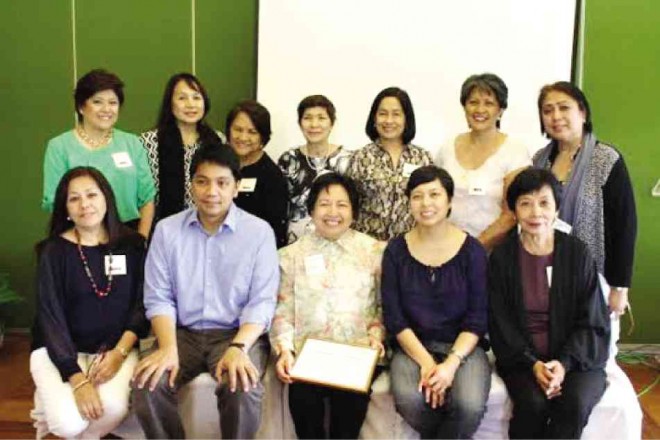
In the face of escalating revelations about corruption in government and high places, and the equally distressing spiraling cost of living, it was an uplifting diversion to have spent a couple of hours one recent morning watching a lecture/video presentation on “Finding the Filipino artist’s soul in Washington, DC.”
Why Washington? I asked myself after receiving the invitation from Fiat (Families in Art), a group of women actively involved in supporting Philippine arts and culture, which hosted the presentation. What lode of information on Filipino art and soul could possibly lie hidden among the malls and halls of power in the American capital?
The answer, supplied by Washington-based Filipino couple Titchie and Erwin Tiongson, is—plenty! And not just of artists, but of other notable Filipino/American personalities, colonial officials, writers, musical and entertainment celebrities who lived, worked, performed at, touched lives, and/or otherwise figured prominently or had some historical or significant link to Philippine-American history as may be gleaned from the Washington, DC, area. And, in the hands of the Tiongson couple, both writers, the PowerPoint presentation was a riveting, instructive catalogue of people, places and events that help burnish an otherwise increasingly tarnished Filipino self-image.
According to the Tiongsons, their project began one evening, as they sat speculating on how many places they could randomly name in the Washington area that had some connection to Philippine-American history and culture. Serious pursuit of the answer began in earnest in September 2012. The result is a blog—Philippines on the Potomac (popdc.wordpress.com)—from which the video presentation is derived. A scholarly work marked by painstaking information-gathering, archival research, the patient tracking down of and interviews with relevant sources, the blog compiles documented data and information, treasures and trivia, and mementos about such places, events and people, as these document Filipino presence and history in Washington. Stories are told in lively anecdotes and charming little vignettes.
Engagement
There is, for instance, a poignant tale about Manuel L. Quezon who, before he became President of the Commonwealth, had to break off his engagement to his American sweetheart when advised that, in the interest of the country and his service to it, it would be ill-advised to marry a non-Filipino. The lady in question never married, and among the souvenirs her nephews and nieces dug up for the project were a silver-handled walking stick with Quezon’s initials, and an engraved (but now stone-less) engagement ring.
Well before swarms of Secret Service agents were a permanent fixture that cordon off access to US presidents, Filipino sculptor and National Artist Guillermo Tolentino waited on tables
at a restaurant near Rock Creek Park. One day, with his 1919 “Pax” sculpture tucked under his arm, Tolentino boldly marched over to the White House and wangled his way to personally present the statue to then President Woodrow Wilson, who subsequently helped him get a scholarship to Ecole des Beaux Arts, an influential art school in France. The sculpture is still at the Woodrow Wilson House in Washington.
The celebrated and controversial poet José Garcia Villa sat in a basement of a building with fellow writer Bienvenido Santos during World War II, clipping news items about Bataan and Corregidor.
Helen Taft, wife of Philippine Governor and later US President William Howard Taft, once wanted to transform the Potomac into a “glorified Luneta” with free open-air concerts for everyone.
Juan Luna (one of the greatest Filipino painters famous for his gold medal-winning “Spoliarium” and “The Battle of Lepanto” paintings) was in Washington with Felipe Agoncillo (husband of Marcela, who stitched the first Philippine flag), not to exhibit his obra but to lobby against the ratification of the Treaty of Paris which ended the US revolution against Britain and gained the nation its independence.
In the music scene, soprano Enya Gonzales was the first female Filipino singer to captivate Washington audiences and win the hearts and applause of the American public.
And the prewar Philippine Constabulary Band holds the distinction of having played at a US presidential inaugural, receiving much acclaim, including from the celebrated Sousa Marching Band.
Of course, there are many other, more recent and familiar names on the list, including those of the Marcoses, Cory Aquino and daughter Kris, Carlos Romulo, Gloria Macapagal-Arroyo, Helen Benitez, to name a few.
To date, the Tiongsons have identified 150 significant and historic sites. Thirty-two of these currently make up their “small walking tour” of Washington. The sites are listed in a limited-run fold-out map, produced in collaboration with the Ateneo Alumni Association in Washington, and which they hope to develop into a full-scale Fil-American street map of Washington, complete with listings of artworks, artifacts, addresses and sites.
Armchair walking tour
Held at Alabang Country Club, significantly enough, on the fourth of July, the armchair walking tour of Washington, DC, was made possible through the help of Vicky Cuisia, wife of Joey Cuisia, Philippine ambassador to the US. Vicky is an active member and former president of Fiat. The event was attended by members of the Alabang-based ladies group and their friends, and proved a welcome and redeeming antidote to the flagging spirits and general sense of malaise that mark the Filipino soul in Manila, which today gropes for but is hard-pressed to even find a credible presidential candidate for the coming 2016 national election.